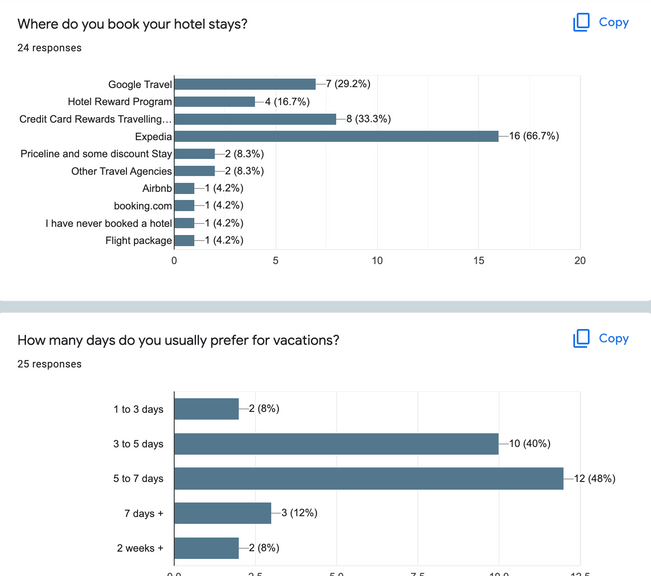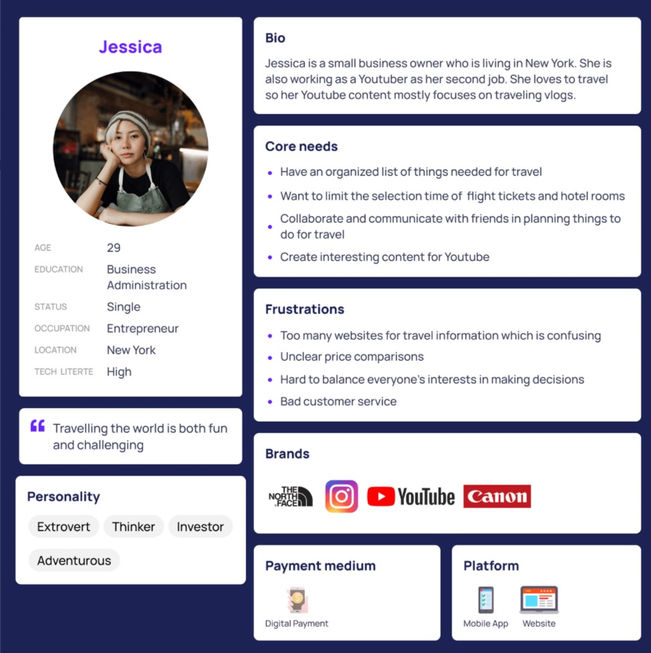Project Overview
Brief:
This Trip Planning App caters to young travelers who value collaboration while planning trips. The app includes basic features such as ticket booking, car rental, and hotel booking. Also, it allows users to invite others and create decision polls to make planning easier and more interactive.
Research
In the early stage of the formative study, we planned and conducted micro-user research to study user habits and narrow down our target audience by doing an online survey. We received over 30 responses to the survey. This helps us narrow done our target user group and target some pain points. By analyzing the research data we gathered, we soon created a persona and user journey map. Other than the survey, we also interviewed four participants about their travel planning experience.
Persona
Based on the data we collected from our previous research, we developed four personas. These personas represent young working professionals aged 21-35 who are interested in budget travel with our company. We combined the main features from each persona to create a final persona and user journey map that accurately reflected the needs and expectations of our target audience. This approach allowed us to create a design solution that addressed the unique requirements of our users and provided a seamless travel planning experience.
User Journey
Map
Drawing from the data collected in our previous research, we developed four personas representing young working professionals aged 21-35 who are interested in budget travel with our company. By synthesizing the main characteristics and needs of each persona, we created a comprehensive user journey map. This map accurately reflects the expectations and behaviors of our target audience, allowing us to pinpoint key touchpoints and pain points in their travel planning experience. By understanding their journey, we were able to design a solution that seamlessly addresses their unique requirements, ensuring an efficient and enjoyable travel planning process.

User Flow & Storyboard
As part of our design process, we first developed a general user flow for the travel app, outlining the key interactions and pathways a user would take. To ensure comprehensive coverage, we divided the features among team members, allowing each to create detailed flows for specific functionalities. Our primary focus was on the User Invitation, Trip Planning, and Voting functions. Subsequently, we created a storyboard based on these core features, visually illustrating the user experience from start to finish. This approach ensured that our design was cohesive, and user-centered, and addressed all critical touchpoints in the travel planning process.

.png)
Branding
& Style Guide
We chose a clean and sophisticated color palette featuring white, black, and navy blue. These colors were selected to convey a sense of trustworthiness and reliability, essential qualities for a travel app aimed at organizing group trips. The minimalist and modern aesthetic ensures that the user interface is not only visually appealing but also intuitive and easy to navigate. By maintaining this cohesive theme throughout the app, we aim to create a seamless and engaging user experience that resonates with our audience's expectations of a dependable travel planning tool.

SOLUTION

Loading
Loading page of the app, with brand logo and theme color.

Plan
Plan page, creating process, with friend invitation option.

Alert
Entry requirement advise for foreign travel.

Profile
User's profile, include reward point tracking.

Plan 2
Plan page, planning process, booking list of all aspects.

Poll
Poll page, visual result for the poll among travel group members.

Home
Home page with promotions and recommendations of travel plan.

Calendar
Calendar page to document every event.

Advise
Recommendations of all aspects of traveling.
Prototype
Usability Test
We conducted a total of four usability tests with participants who matched the demographics of our target audience - young travelers aged 21-35. Each team member conducted a single session remotely or virtually, during which we recorded the session and took notes on key findings. Following the usability tests, we analyzed the data we collected and identified patterns to summarize our research insights. This rigorous approach allowed us to gain a deep understanding of our users' needs and expectations, informing our UI design process and enabling us to create a solution that provided a seamless travel planning experience.



Reflection
Throughout this project, I gained invaluable learning experiences, including trying out the user journey method for the first time. Conducting a large number of user surveys was also a new and challenging experience, but analyzing and summarizing the results greatly informed our design process. While not all of my initial ideas were ultimately realized, I am pleased with the successful implementation of several interesting features. Overall, this project enabled me to refine my UI design skills and provided a unique opportunity to create a user-centered solution that met the needs and expectations of our target audience.







